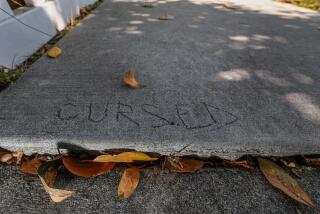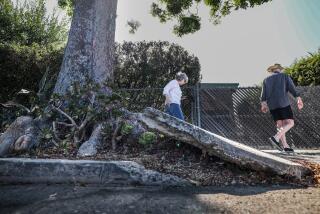To Ad Man, Every Street Is a Street of Dreams
- Share via
Connoisseurs of classic furniture treasure their Hepplewhite, wax enthusiastic over the elegant lines of a Duncan Phyfe, relish the intellectuality of a Marcel Breuer. But nobody pays much attention to what decorates the streets of Los Angeles. Nobody, that is, but Joe Blackstock.
“Street furniture” is Blackstock’s passion. He takes pleasure in what others ignore--everything from utility poles and traffic lights to bus shelters, billboards and trash baskets. Where they see a monotonous terrain of cars, gas stations and fast-food outlets, he gazes appreciatively at a constantly shifting landscape where everything has its place, purpose and own special character.
As director of research for an outdoor advertising company, it is Blackstock’s job to carefully observe city streets and report on their changes. Describing his work as “a continuous pleasurable experience for which I get paid, and which I do on Saturday and Sunday, on my own time, as well,” he ruffles at the suggestion that city streets here may not warrant such scrutiny.
“Time and time again I’ve heard people comment that most or all L.A. arterials ‘look the same,’ and, ‘If you’ve seen one, you’ve seen them all.’ ” The fact is, “No one street in Los Angeles is similar to any other. Each is completely distinctive and no one is greatly more interesting than the other.”
Tracked City Changes
Take Melrose Avenue and Alameda Street. “At first glance Melrose is a more captivating arterial than Alameda. The trendy, funky stores--the dress, actions of both pedestrians and drivers can catch the eye and the mind,” he says.
But Alameda, “possibly the only long street in the world on which trucks predominate in number over passengers,” is more interesting from a historical view. For him, it will always be the street of “big hobo camps during the Depression, the old Southern Pacific station, and the opening of Union Station. And a host of other memories not present at all on Melrose.”
Always Up-to-Date
Blackstock, 67, has tracked many changes for his employer, Patrick Media Group, as well as an informal group of amateur historians interested in the city’s evolution. In the last 48 years, Blackstock estimates he has walked most of the city’s 5,728-mile network of roads and inspected most of its 1,821 major intersections. And while he doesn’t claim to have been inside all 9,687 food markets, 2,110 drugstores, 3,077 used car dealers or 27,731 eating and drinking places, he is almost always up-to-date on their numbers.
So what gave rise to this unusual obsession?
He recalls becoming a dedicated street watcher at age 10. “I was growing up in Compton, and I remember two storekeepers arguing furiously about which side of the street, the sunny side or the shady side, was better for business. It struck me as wonderful that people would be so caught up in life around them.”
Studied Traffic Patterns
At 18, he dropped out of Pasadena City College and began working at Foster & Kleiser, an outdoor advertising firm that would later become Patrick Media. From a job as an office boy, Blackstock was promoted to sales. Then fate proved kind and a spot opened up in research.
“It was fortuitous,” he recalls. “I could always be walking the streets, standing and watching cars,” studying traffic patterns and gathering the data needed to sell billboard advertising space.
Today his job remains much the same. With clipboard in hand and pens in his pocket, “a man is respected and never harmed. You can easily ask any questions,” the Alhambra resident says.
The happiest development in years, he says, has been the big, blue, reflecting street signs posted on light standards at intersections. “I think that was a Los Angeles innovation and it’s got to be one of the best for helping to orient the motorist.”
Gray Telephone Boxes
The perfect trash basket, he notes with authority, “should be closed, not open, and painted a harmonious color.” And telephone booths should be any color but neutral. “For some reason the telephone company always preferred gray. Why, I don’t understand. Good Lord, if somebody were lying in the street and you had to call for help and you looked around and all there were were gray phone boxes you’d never find one. The British had the right idea in painting them red. Now the phone company is going over to brighter colors.”
How street furniture affects pedestrian travel “varies considerably, due to the width of the sidewalk and how such furniture is dispersed.” And herein lies a sad tale, he says.
Los Angeles’ older streets, according to Blackstock, are simply too narrow. Originally one lane in each direction, “apparently no one anticipated how many cars there were going to be.” The result has been a trimming down of sidewalks.
Less Room for Pedestrians
Meanwhile, advances in fire fighting and traffic control have meant more street furniture and less room for pedestrians. All Western cities are experiencing similar pedestrian congestion, he hastens to point out. “Not just L.A.”
Streets vary in the type of traffic they attract and the speed of flow. Blackstock says he has spent many pleasurable hours counting the cars that pass a certain intersection, noting the model types, their production years, and even the occupants.
They also attract different types of businesses. But he is not distraught by one recent development, the rise of the much-maligned mini-malls. They are for him as a major shift in the San Andreas fault would be for a geologist: a new wrinkle in a slow-moving but eternally dynamic process. “If (the mini-mall) wasn’t meeting somebody’s need,” he says philosophically, “it wouldn’t be there.”
It only makes sense that Blackstock’s family has had some share in his obsession. His wife of 42 years, Doris, approves of his interest “and she even goes street-walking with me, although only on the weekends.” When his two sons were young, he adds, “I outfitted each of them with his own clipboard and we’d all go out together.”
Asked to name his favorite thoroughfare in Los Angeles, Blackstock pauses. Pacific Avenue in Huntington Park, is a great shopping street, he says, and Whittier Boulevard is another, the great arterial of the city’s Eastside. Then there’s Wilshire Boulevard, of course, the city’s first modern “Broadway.” But in the final analysis, he decides: “I have to enjoy the street I’m on. That’s the street of the day.”






